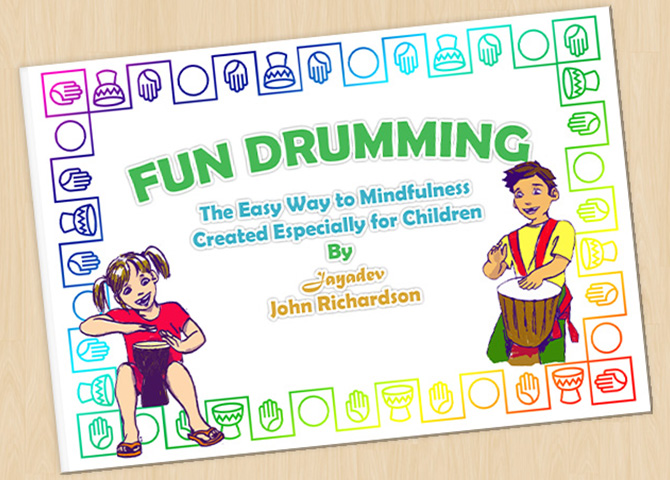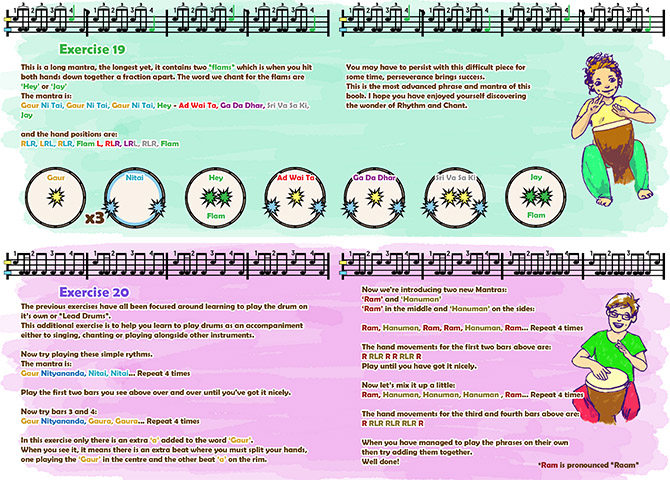
What is it?
What is Fun Drumming?
Fun Drumming is a new book written by famed musician and alternative therapist Jayadev John Richardson.
Fun Drumming has been specifically designed to help introduce children to the concept of mindfulness through the power of rhythm and music, whilst at the same giving them an introduction into drumming techniques and musical theory.
An Interview with the Author:
What gave you the idea to write this book?
I’d had an extremely busy year of constant touring with my oldies band “The Rubettes”. No sooner had we finished a successful UK tour when we began a sixty date tour of Europe. On a rare day off a friend had asked me if I could give her son some hand drum lessons to help boost his confidence. The session went wonderfully well. The boy responded so enthusiastically to everything I showed him and very quickly learned the techniques.
To help him pick up the rhythm I asked him to recite short mantras which fitted to the beats such as “Nitai Gauranga, Nitai Gauranga” and Ram Hanuman, Ram Ram Hanuman” each syllable being placed on a different part of the drum to elicit different sounds.
The lesson went so well that later that evening I got the idea of writing a drum book for children using mantras as I had done that day.
Within a few weeks I had created “Fun Drumming for Kids”
Can you describe what you hope to teach children with it?
This is a drum book with a difference. It not only teaches children to read drum dots and how to play them nicely, but with the introduction of chants they can very quickly attain mindfulness. Mindfulness is being taught in schools up and down the UK, but not with drum and mantras which is a whole new concept.
In the tradition that I have been following for 35 years we use a drum called a “mrdanga”, a clay drum and when you learn this instrument you are given mantras to help you remember and execute the hand patterning. So taking a leaf from that book I began using my own mantras and applied them to the most popular of hand drums, the “djembe”.
And how easy and accessible drum skills can be when learned in this fashion; the process is as it states, fun, but also empowering.
How are the lessons presented? What is unique about the teaching style?
The illustrations are self-evident and the drum music at the top of the page means that if they wish to also combine their hand skills with reading the dots they will end up with, not only the ability to play nicely, but with a fundamental grasp of written musical values which can only stand them in good stead for any future musical ventures.
The student is shown what a minim, crotchet, quaver and semiquaver look and sound like and how, when and where to play it.
Then triplets are introduced followed by how to play accents and phrases. All of this is easily absorbed and remembered due to the mantras that accompany the rhythms.
The book can also be used by a teacher for one to one instruction or class by class as is relevant.
If they haven’t got drums, desk tops will do, or even knees (don’t hit too hard though!)
Teaching these classes is a joy for both teacher and pupil.
How will this benefit children?
I am desperately interested in children and how they navigate the educational experience and of course, childhood in general which is such a vital time for them.
In the West our kids do have “more” but that “more” brings with it an array of bewilderment, so many quick fixes, so many distractions, but very few lasting values.
It is in that area, the area of permanence, of truth, of integrity and love that I am drawing from my 70 years of experience on the planet. My Fun Drumming book is drawn from not what I’ve read, but what I’ve experienced.
If folk would rather not sing along, but just follow the hand movements…great…if rather than saying “Gaur Nitai” they would prefer to say “right left left”…great. If they would like to replace any of the mantras I have used with phrases from their own tradition, then great, be my guest. Just be happy!


